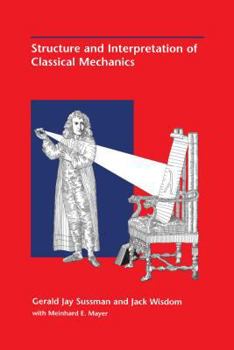Structure and Interpretation of Classical Mechanics
Select Format
Select Condition 
Book Overview
The new edition of a classic text that concentrates on developing general methods for studying the behavior of classical systems, with extensive use of computation.We now know that there is much more... This description may be from another edition of this product.
Format:Hardcover
Language:English
ISBN:0262194554
ISBN13:9780262194556
Release Date:March 2001
Publisher:MIT Press
Length:526 Pages
Weight:2.20 lbs.
Dimensions:1.4" x 6.3" x 9.2"
Age Range:18 years and up
Grade Range:Postsecondary and higher
Customer Reviews
4 ratings
The tragedy is
Published by Thriftbooks.com User , 19 years ago
that despite being a brilliant book, the best part, the executable code is extremely difficult to run as it works only on an obscure MIT scheme implementation. It would easily earn 5 stars if it ran in PLT scheme for instance.
Expensive book... worth a look online
Published by Thriftbooks.com User , 22 years ago
If you're reading this review now, you're considering whether this text is worthy of your [money]. Well, stop the guessing, and just read the darn thing for free at [the website]I've found the first part of it is the same classical stuff I've seen over and over, but in a new light, differently perceived, and worthy of, sometimes, just closing the book and thinking about the implications. Take what I say with a grain of salt, as I've not nearly read everything. See for yourself, as well. There'll be no mystery. (The famed "sister text," SICP, is also online as well at the appropriate address)
New milestone
Published by Thriftbooks.com User , 22 years ago
I can't rave enough -- by page 27, Sussman crisply solves a fundamental problem that I noticed as a schoolboy decades ago, and for which I never found a satisfactory solution despite discussing it with generations of the world's finest physicists, and that is, how, in Lagrange's equation, can @L/@q be treated independently of @L/@q_dot when q_dot depends on q through dq/dt=q_dot by assumption? Having had a lifelong mystery dispatched in a footnote, I am breathlessly working my way through the rest. I expect this will be a book I revisit every few years or so, like SICP, Abelson & Sussman's book on Computer Programs. EDIT: As noted by another reviewer, it is a shame that one needs to be a Linux sys-admin to run the software as it stands. However, it is possible to rewrite the programs in Haskell or Mathematica on more commonplace platforms. It is also not actually necessary to run the programs as they stand -- the book is good just to read.
Structure and Interpretation of a Great Text
Published by Thriftbooks.com User , 22 years ago
Among the horrors of modern education is the production of vast quantities of poorly written, error ridden science text books. This is in spite of the fact that many if not most of the great scientists of the 20th century have been excellent writers and lecturers. Einstein and Feynman are important examples: brilliant in their discoveries, they were equally brilliant in their abilities to describe and explain some of the most difficult concepts of science. We should be asking why these people can write about their work with such perfection while the "professionally produced" text books in our high schools and colleges are so mediocre.The MIT Press stands among those publishers producing the very best work. Sussman's and Wisdom's text, "The Structure and Interpretation of Classical Mechanics", provides a wonderful example. Here is a book providing further proof that (a) great science necessarily includes excellent writing and communications, (b) brilliant scientists tend to be the best writers in their fields, and (c) a text book on a difficult subject can be remarkably enjoyable as well as informative when well conceived and well written.The very first chapter, "Lagrangian Mechanics", is worth the price of admission. It has all the attributes which make the entire book a gem: it is concise, efficient, clear, compact, full, and rewarding. Every sentence contains important ideas and information, yet each sentence is clear and direct. These are attributes usually associated with poetry, and one could argue that this text book approaches that level of literature. In the first three pages of the chapter, the authors present as complete a discussion as I've read on the relationship of mathematics to natural phenomena, the basic project of classical mechanics, and the "remarkable discovery that the same mathematical tools used to describe the motions of the planets can be used to describe the motion of the juggling pin." Furthermore, the chapter introduces and describes the concepts of configuration paths, variational formulation (and why that has some advantages over the classical Newtonian formulation), generalized coordinates, and the relationship of these formulations to a computer program in Scheme.By the end of the chapter, students will be immersed in the subject out of interest, and will fully appreciate the themes and likely outcomes of the book. Classical mechanics will essentially "come to life" through a well structured use of computers to achieve a very deep understanding of classical systems.Jump next to the book's Appendices, which present an introduction to the computer programming language of Scheme and a full explanation of the authors' adaptation of functional mathematical notation. Scheme is wonderfully crafted language for exploring, describing, and demonstrating science and mathematics. The mergence of Scheme, functional notation, and classical mechanics in a single text while retaining almost luminescent clarity ranks among great




